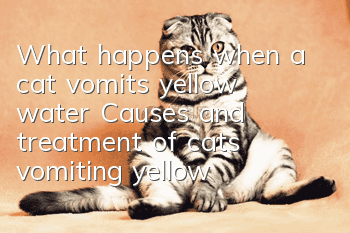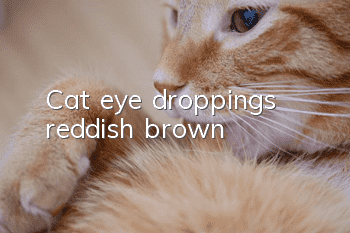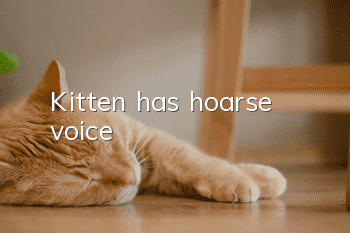What happens when a cat vomits yellow water? Causes and treatment of cats vomiting yellow water!

What should I do if my cat vomits yellow water?
What happens when a cat vomits yellow water? Causes and treatments for cats vomiting yellow water! Vomiting has always been a common symptom of cats. Sometimes cats will vomit yellow water when they vomit, which often makes parents I am very worried. Indeed, vomiting yellow water is a symptom of some serious diseases, which means that the cat is extremely uncomfortable. However, there are many causes of this situation, and it requires examination and symptomatic treatment.
1. Hairy bulb gastritis
Cause: When the cat is grooming its coat, it licks the shed hair into its stomach, and the coat becomes Hairballs accumulate in the gastrointestinal tract and form hairballs. Due to some reasons, the hairballs cannot be discharged in time, and they are repeatedly stimulated in the stomach to form foreign body gastritis or obstruction. This disease is more common in long-haired cats and shorter-haired cats.
Symptoms: Cats with hairy balls in the stomach show retching. Some cats want to eat, but then leave after a few mouthfuls. In severe cases, cats do not eat, gradually lose weight, and the stomach is sensitive to palpation. If a cat retches or spits out hairballs and mucus, the cat may have a hairball problem.
Treatment:
1. Feed Maoxiang Hair Cream every week to inhibit the formation and development of hair balls, and smoothly expel hair balls. If you have time, plant cat grass seeds at home, etc. When the leaves grow, feed them to the cat.
2. In terms of cat food selection, change to a cat food containing more crude fiber.
3. In severe cases, gastrotomy is required to remove the hair bulb.
2. Internal parasites irritate the gastrointestinal tract
Cats that are three months old must start internal deworming. If they have not been dewormed yet, it may be parasites. Stimulates the cat's gastrointestinal tract and leads to vomiting. In this regard, you can use Maobei Chongqing to deworm the cat in time. Remember to use the dosage according to the instructions. After 2 hours, take 5 grams of Miaoxiang probiotics to regulate the gastrointestinal flora, otherwise you will overdose. Leading to obvious side effects.
3. Acute gastroenteritis
Cats are more likely to get gastroenteritis due to weather conditions, improper feeding, sudden changes in food, catching cold, and fright Various reasons such as stress, poisoning and allergies may cause gastroenteritis in cats.
Cause: The treatment principles are to remove the cause, reduce inflammation, stop diarrhea, and replenish fluids. Corresponding treatment measures should be taken according to the different causes. If gastroenteritis is caused by overfeeding, feeding should be stopped for one day to ensure adequate drinking water. During the treatment period, good nursing care should be provided, such as providing a small amount of delicious and easy-to-digest liquid food. In terms of medication, take gentamicin for a week, and half an hour later, take Miaoxiang probiotics and observe whether it gets better within a week. If not, you must send it to a pet hospital for treatment.
4. The cat ate the wrong thing, such as spoiled cat food or rotten food
In this case, everyone must remember to fast the cat first 12 hours, and then feed the cat some cool flower water, and then target the cat’sMake a detailed observation of the spirit and state. After a certain period of recuperation, the cat can recover quickly. What needs to be distinguished is that the diarrhea and vomiting caused by cats after eating rat poison is not yellow water, but white foam. In this case, you must be sent to the doctor as soon as possible, otherwise it may be life-threatening.
5. Gastritis
① Secondary to other diseases, such as feline distemper, gastrointestinal parasites, peritonitis, pancreatitis, etc.
② It can be caused by accidental ingestion of poisons, such as rat poison, arsenic, mercury, lead, phenol, etc.
③ Vitamin and mineral deficiency.
④ Bacterial infections, such as salmonella, E. coli, etc.
Symptoms: Vomiting, diarrhea, abdominal pain, depression, elevated body temperature, and dehydration are the main symptoms.
The affected cat will feel thirsty and lie by the water bowl without drinking or will vomit after drinking. The vomitus contains blood streaks and yellow-green liquid. The animals showed high levels of dehydration, sunken eyeballs, and decreased skin elasticity. The frequency of defecation increases, the feces is thin and smelly, and a large amount of feces sticks around the anus. The animal resists abdominal examination and may show symptoms of vomiting when the stomach is palpated.
Treatment:
1. Fasting and fasting for 12 hours.
2. Symptomatic treatment, give antiemetics, metoclopramide 2 mg/kg body weight, 2 times/day;
3. Anti-inflammatory rehydration, gentamicin 10,000 units /kg body weight, dexamethasone 0.5 mg/kg body weight, mixed intramuscular injection, 2 times / day, half an hour later, take 20 grams of glucose water and 3 grams of Miaoxiang probiotics orally.
4. Care, provide liquid food, broth, fish soup, and gradually transition to normal feeding food.
In addition, if the cat has not been vaccinated, it may be infected with feline distemper. In addition to vomiting yellow water, the incubation period of feline distemper is 2-9 days. The clinical symptoms are related to the age and virus virus. Power related. Kittens often suffer from acute illness, with body temperature rising above 40°C and vomiting. Many cats do not show any symptoms and die suddenly. Some may show symptoms of spinal ataxia.
Most cats over 6 months old show subacute clinical symptoms. They first have a fever to about 40°C, then drop to normal temperature after 1-2 days, and then rise again after 3-4 days, which is the biphasic fever type. The sick cat is in low spirits, anorexia, and has stubborn vomiting. The vomit is yellow-green, and there is sticky secretion in the mouth, eyes, and nose, and the feces is sticky. When diarrhea occurs, it means that the animal is in the late stage of the disease, with blood in the feces and severe dehydration. , anemia, severe cases death. If you have the above symptoms and you are not a professional veterinarian, send the cat to a pet hospital for treatment in time.
6. Cat Distemper
The main symptoms of Feline Distemper are fever, which can reach 40~41°C; listlessness and anorexia, and in severe cases, even inability to drink water. Progress; the most typical symptom is frequent vomiting, vomiting not related to eating, and the vomitus is yellow and bile-like, that is,Even if the cats have not eaten or drank for several days, they can still vomit or have diarrhea. The degree of diarrhea is not exactly the same for every cat. In severe cases, watery and bloody stools may occur, and a lot of diarrhea may occur in a day. Cats with mild symptoms may only have unformed and pulpy stools; as the condition worsens, they may have diarrhea and bloody stools, or even excrete intestinal mucosa (mucus or flake or strip-like objects in loose stools) due to constant Ground vomiting and diarrhea, sick cats will quickly develop symptoms of dehydration (poor skin elasticity, sunken eyes).
For the treatment of feline distemper, it mainly involves injection of feline distemper monoclonal antibody and feline interferon, parenteral infusion to supplement electrolytes and nutrients and correct dehydration, improve vomiting symptoms, and administer broad-spectrum antibiotics for prevention. Secondary bacterial infection is the focus. If severe anemia occurs, whole blood or plasma transfusion should be considered. Hospital treatment is mainly based on injection of feline distemper monoclonal antibody and feline interferon. Of course, prevention is always better than treatment, so vaccination in advance to protect your cat is the best way.
- Does a female cat have gills?
- Why do cats like to crawl into boxes?
- Is it cat plague when a cat vomits yellowish paste?
- Cat has fever after vaccination
- Why are pedigree cats expensive?
- What are the characteristics of flame-colored ragdoll cats?
- How to tell the age of a cat?
- What are the precautions for transporting pet cats?
- How to correct a cat’s picky eating
- Food taboos for American wirehair cats



